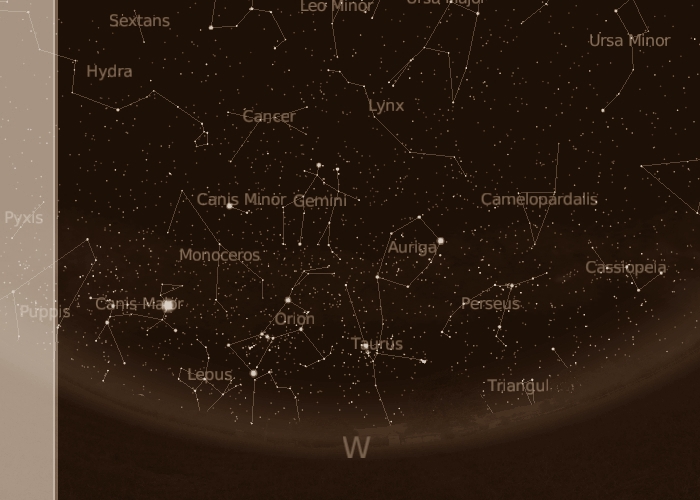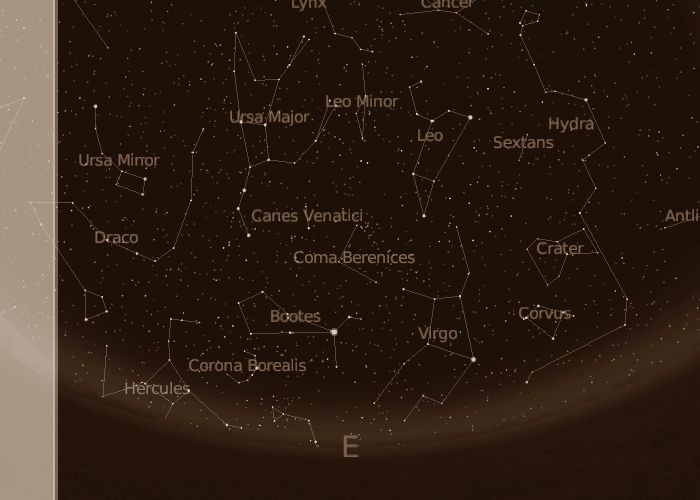Western Horizon
Eastern Horizon
![]()
Western Horizon
Eastern Horizon

Winter is coming to its end. Further, it's the vernal equinox this month. Hence the sky we see is transitioning from the winter features to the spring ones! Let's turn West! The great winter sky, that set of fine constellations and bright stars which are the distinctive mark of the winter skies in the northern hemisphere, has now largely shifted West and southwest. Orion and Taurus are now tending low. Orion, the Hunter is this large quadrilateral of stars, easy to spot, and with three stars aligned in its center. Orion allows to find, by alignment, the other constellations and stars of this region of the sky. Aldebaran is in line, to the right, with the three central stars -which are called the 'Orion's Belt', as Sirius is just on the other side. Sirius is the main star to constellation Canis Major, the Great Dog -and the sky's brightest. Canis Major is now low southwest. Linking the lower right star of Orion -Rigel namely- to the upper left one -Betelgeuse- and following this line brings you to another large quadrilateral of stars. These are Gemini, the Twins. To their lower right, the bright Capella is the main star to Auriga, the Charioteer, as Procyon and Canis Minor, the Little Dog, is to their lower left. All that parts of the winter sky are still high. Perseus, Perseus keeps being a target of interest northwest as the sky's zenith is harbouring faint constellations, from Cancer, the Crab to Camelopardalis, the Giraffe. to a printer-friendly chart
West for the tropics. West for the mid-southern latitudes

It's East that the transition between the winter and the spring skies is felt the most. Leo, the Lion, or Ursa Major, the Great Bear -with the Great Dipper- are now high, as the row below them are mostly spring. Both bright stars East and southeast are the famed Arcturus and Spica, respectively, those bright stars of the constellations Bootes, the Herdsman and Virgo, the Virgin. The specificity of those stars is that they belong to a well-known astronomical mnemotechnics, which states: 'Arc to Arcturus, speed on to Spica.' This means that, if you consider the Dipper's handle, this line of three stars, and that you extend the general direction of its bent, this leads you to Arcturus, and, further, to Spica! A fine trick! Hydra, the Hydra, southeast is well bound now for its spring position, South. Hydra is a fine constellation, from its head, near Cancer, the Crab, down to the horizon. Three small and fine constellations are anchoring along. Sextans, the Sextant, Crater, the Cup, and Corvus, the Crow. Draco, the Dragon is now well observable northeast. A fine show, as Draco is meandering between Ursa Major and Ursa Minor. Coma Berenices, the Berenice's Hair, between Arcturus and Leo, is a field of deep-sky galaxies. Fine views are seen on the northern horizon, at last, with Cepheus, Cepheus is now well showing it's a circumpolar constellation, passing over the horizon, as Draco is to its right, Cassiopeia, the Queen to its left, and that Polaris is hanging above. to a printer-friendly chart
East for the tropics. East for the mid-southern latitudes
(color maps with Stellarium; printer-friendly charts with Cartes du Ciel, Patrick Chevalley)
Website Manager: G. Guichard, site 'Amateur Astronomy,' http://stars5.6te.net. Page Editor: G. Guichard. last edited: 12/28/2010. contact us at ggwebsites@outlook.com